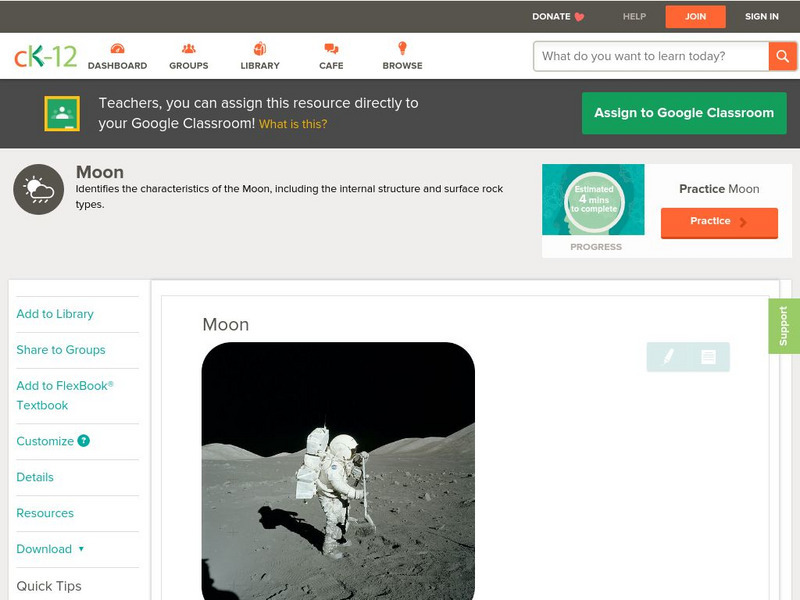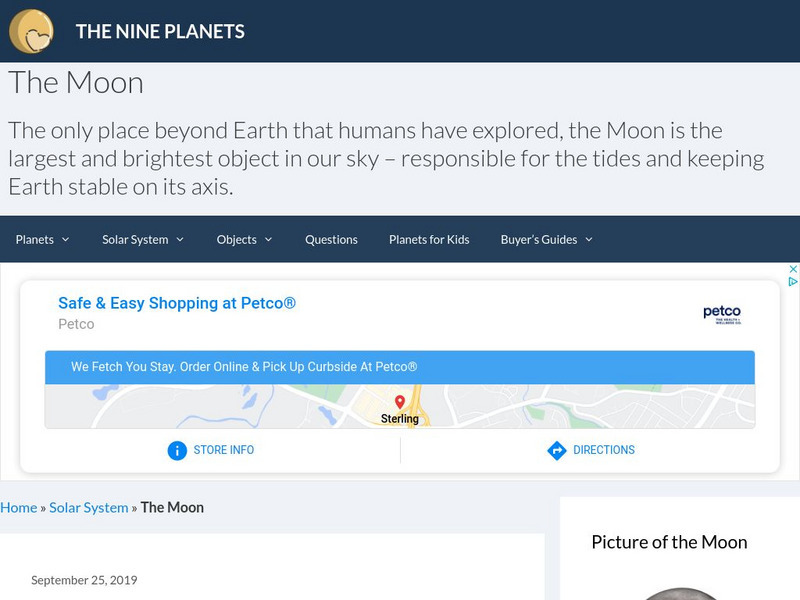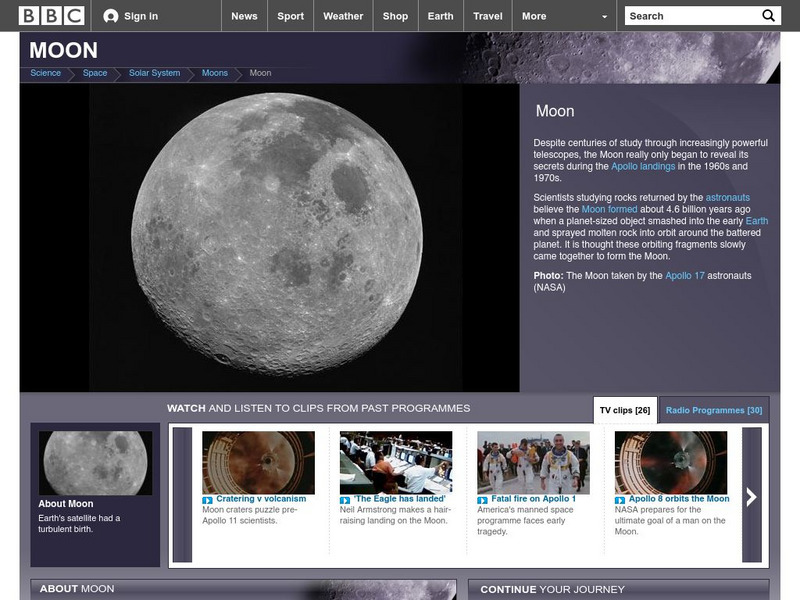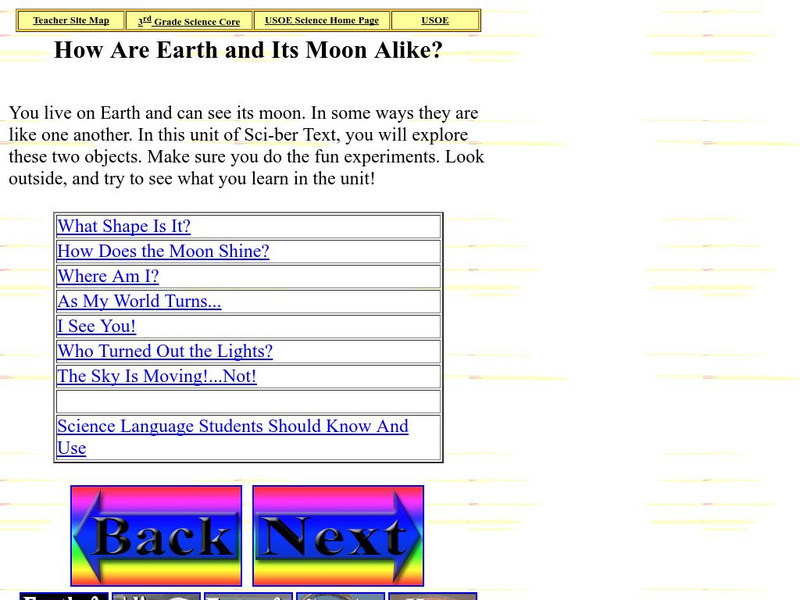Utah Education Network
Uen: Trb 3:1 Investigation 1 Comparing the Earth & Moon
Third graders compare the earth and the moon in this activity.
The Wonder of Science
The Wonder of Science: Ms Ess1 1: Earth Sun Moon System
Develop and use a model of the earth-sun-moon system to describe the cyclic patterns of lunar phases, eclipses of the sun and moon, and seasons.
CK-12 Foundation
Ck 12: Earth Science: Moon Study Guide
A general overview and review guide of the moon.
Utah Education Network
Uen: Earth and Moon Observations
Earth's revolution, rotation, tilt, day and night cycle, and the sun's apparent movement across the earth are explored.
NASA
Nasa: Space Place: Dr. Marc Answers Questions About Earth & Moon
Discover facts about the Earth and the Moon with NASA scientist, Dr. Marc Rayman.
Fourmilab Switzerland
John Walker: Earth and Moon Viewer and Solar System Explorer
This website provides numerous images of the Earth and moon, shown from various vantage points.
Other
Planetary Society: Relative and Absolute Ages in Histories of Earth and the Moon
A lengthy scholarly article that discusses the geologic time scale, its history of development, age-dating events that occurred in different eras, and how absolute and relative dating are used to assess the ages of the Earth and Moon....
PBS
Pbs Learning Media: Earth and Moon
Students are asked to compare and contrast the earth and the moon.
CK-12 Foundation
Ck 12: Earth Science: Moon
[Free Registration/Login may be required to access all resource tools.] Identify characteristics of the Moon.
CK-12 Foundation
Ck 12: Earth Science: Moon
[Free Registration/Login may be required to access all resource tools.] Identify characteristics of the moon.
Fourmilab Switzerland
Earth and Moon Viewer
View a map of the Earth showing the day and night regions at this moment, or from the sun, the noon, the night side, and other points of view in this simulation. Illustrated.
Science Education Resource Center at Carleton College
Serc: Investigating Earth and Moon Surface: Impact Craters
In this activity, students will investigate how impact craters are formed. In small groups, students will build a model of the moon's surface with flour paste and drop a marble from different heights to discover how the speed of an...
NASA
Nasa: Earth's Moon: Overview: Our Natural Satellite
Prepared by NASA, this site provides a detailed look at the Earth's moon. The menu tabs are divided into overview, photo gallery, and facts and figures.
Nine Planets
The Nine Planets: The Moon
Explore the mythology, structure, observational history, gravitational force, and orbit of Earth's Moon.
NASA
Nasa: Space Place: How Far Away Is the Moon
Often when we see drawings of the Earth and the moon, they look really close together. Check out this cartoon series that helps illustrate the reality of this concept.
PBS
Pbs Learning Media: Why Doesn't the Moon Fall Down?
In this animated video segment adapted from NASA, astronomer Doris Daou explains how the forces of speed and gravity keep the moon in a constant orbit around Earth. [1:36]
BBC
Bbc Science and Nature: The Moon
The BBC brings together a lot of useful information about the moon and related topics, such as the lunar landings, and publishes it in the form of a traveler's guide.
Globio
Glossopedia: Moon
Orbiting around Earth at an average distance of 384,392km is our constant companion, the Moon. This and a great deal more can be learned about our closest neighbor in this article by GLOBIO
PBS
Pbs Learning Media: Epic Earth
This mesmerizing video shows seven views of the earth taken by NASA's camera. Watch the moon cross over the earth, storms in the ocean, and smoke from a wildfire. Included are teaching tips for teachers and background information.
BBC
Bbc Schools: Ks2 Bitesize: Science: Physical Processes: Earth, Sun, and Moon
Help Sarah Jane and her team put the solar system's planets back in order. Following the activity, read more about the sun, the Earth, and its moon, and then take a quick quiz to check for understanding.
Utah Education Network
Uen: A Moon With a View
Understand the rotation of the earth and the appearance of movement of other bodies in the sky.
Utah State Office of Education
Utah Science: How Are Earth and Its Moon Alike?
Participate in the experiments offered by Utah Science and discover the similarities between the Earth and its moon.
Georgia Department of Education
Ga Virtual Learning: The Moon
In this interactive tutorial students will explore what it is like on the Moon. Learn why the shape of the Moon seem to change and also about lunar eclipses. Discover why the tide changes twice a day and explore how the cycle of the Moon...
Other popular searches
- Earth Science Moon Phases
- Earth Moon Sun System
- Moon and Earth Movement
- Sun Earth and Moon
- Moon Earth
- Earth and Moon Relationship
- Compare Earth and Moon
- Sun Moon Earth
- Earth and Moon and Sun
- Earth, Moon and Sun
- Forces Earth and Moon














